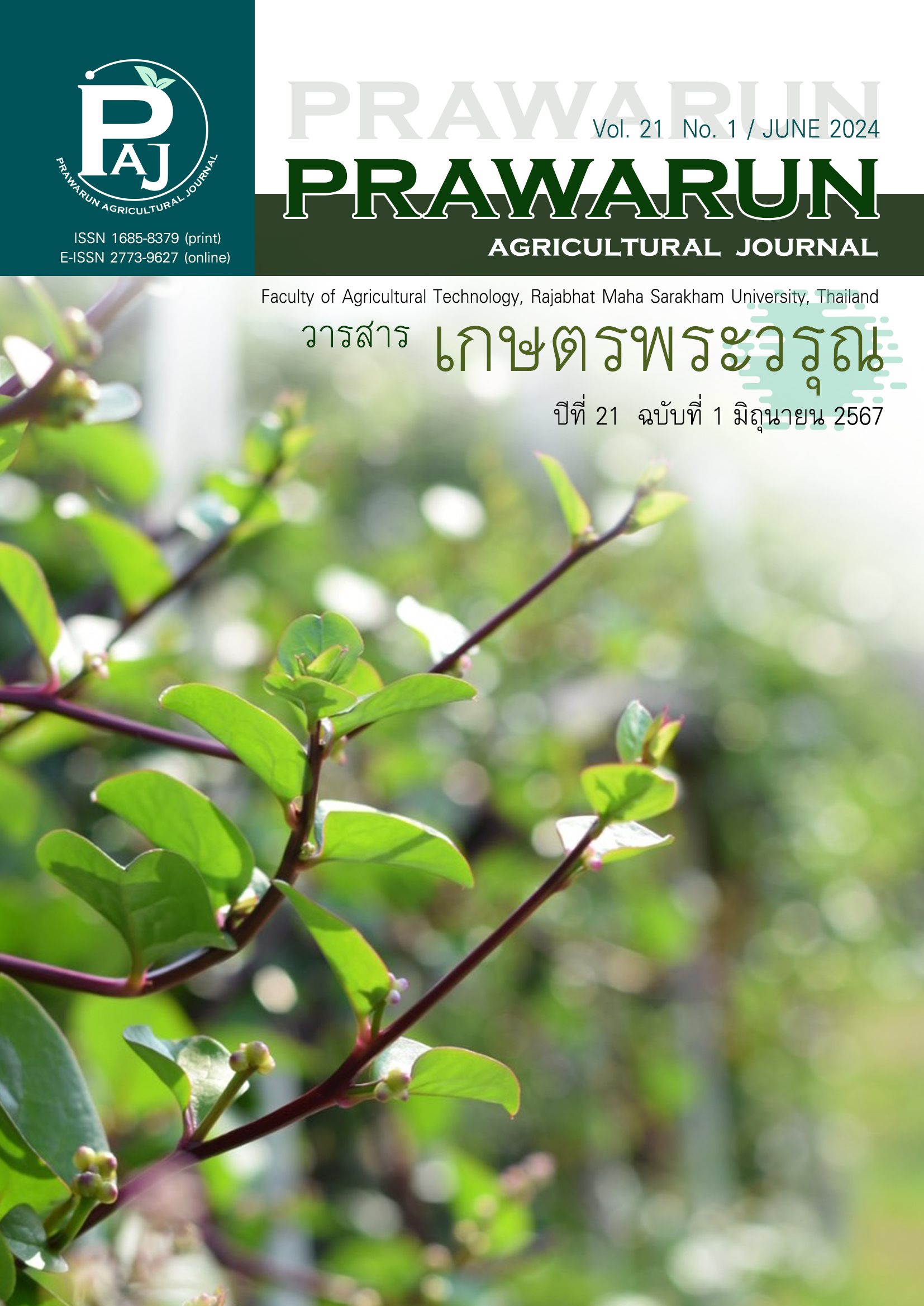โครงสร้างทางพันธุกรรมของประชากรไก่เบตงที่รวบรวมมาจากพื้นที่ที่แตกต่างกัน โดยใช้เครื่องหมายอินเดล
Main Article Content
บทคัดย่อ
การศึกษาครั้งนี้จึงมีวัตถุประสงค์เพื่อศึกษาความหลากหลายทางพันธุกรรมและโครงสร้างประชากรของไก่เบตงที่รวบรวมมาจากพื้นที่ที่แตกต่างกัน ได้แก่ ไก่เบตงพิกุลทองจากศูนย์ศึกษาการพัฒนาพิกุลทองอันเนื่องมาจากพระราชดำริ จังหวัดนราธิวาส (A) ไก่เบตงจากฟาร์มตัวอย่าง จังหวัดยะลา (B) ไก่เบตงจากฟาร์มเอกชนบ่อน้ำร้อน จังหวัดยะลา (C) และ ไก่เบตงจากฟาร์มปฏิบัติการสัตวศาสตร์ คณะทรัพยากรธรรมชาติมหาวิทยาลัยสงขลานครินทร์ จังหวัดสงขลา (PSU) รวมทั้งสิ้น 60 ตัว วิเคราะห์ด้วยเครื่องหมายอินเดล จำนวน 10 ตำแหน่ง ผลการศึกษาพบตำแหน่งที่มีความหลากหลาย ทั้งหมด 7 ตำแหน่ง และพบว่าค่าเฉลี่ยของอัตราส่วน Polymorphic loci (Ppoly) เท่ากับ 0.750±0.068 เมื่อพิจารณาจากค่าเฮทเทอโรไซโกซิตี้คาดหมาย (He) พบว่า มีค่าเฉลี่ยเท่ากับ 0.299±0.038 การวิเคราะห์ Analysis of molecular variance (AMOVA) พบว่า ความแปรปรวนที่เกิดขึ้นในประชากรส่วนใหญ่เกิดจากความแปรปรวนภายในประชากร (91 %) เมื่อพิจารณาผลจากการความแตกต่างทางพันธุกรรมจากค่าสัมประสิทธิ์ F (F-coefficient) พบว่าในประชากรทั้งหมดพบการลดลงของเฮทเทอโรไซโกซิตี้เพียงเล็กน้อย (FIT = 0.016±0.035) ไม่พบการเกิดการผสมเลือดชิดในประชากรย่อย (FIS = -0.094±0.041) และมีความแตกต่างทางพันธุกรรมอยู่ในระดับปานกลาง (FST = 0.098±0.030) จากผลการวิเคราะห์ของ Neighbor-Joining (NJ) แสดงให้เห็นถึงความใกล้ชิดกันของไก่เบตงจากฟาร์ม A B และ C สำหรับการวิเคราะห์ Principal component analysis (PcoA) และวิเคราะห์โครงสร้างประชากร (Structure analysis) พบว่าสามารถจำแนกกลุ่มประชากรไก่เบตงออกเป็น 2 กลุ่มที่แตกต่างกัน (∆K = 2) จากการศึกษาครั้งนี้สรุปได้ว่าเครื่องหมายอินเดลสามารถใช้ในบ่งชี้โครงสร้างทางพันธุกรรมของประชากรไก่เบตงที่รวบรวมมาจากพื้นที่ที่แตกต่างกันและอาจนำไปประยุกต์ใช้เพื่อศึกษาโครงสร้างทางพันธุกรรมของไก่พื้นเมืองสายพันธุ์อื่น ๆ ได้
Article Details
เอกสารอ้างอิง
Angkuraseranee, T. (2019). Phenotype and performance of Betong chickens in three southern border Provinces (Pattani, Yala, and Narathiwat). STOU Journal of Agriculture, 1(1), 96-103. (in Thai)
Buranawit, K., Chailungka, C., Wongsunsri, C., & Laenoi, W. (2016). Phenotypic characterization of Thai native black-bone chickens indigenous to northern Thailand. The Thai Journal of Veterinary Medicine, 46(4), 547-554. doi: 10.56808/2985-1130.2773
Choomee, K., & Worananthakij, W. (2017). Genetic diversity of Thai native chickens using RAPD technique. Proceedings of the 55th Kasetsart university annual conference: science and genetic engineering, architecture and engineering, agro-industry, natural resources and environment (pp. 152-159). Bangkok:, Thailand Kasetsart University. (in Thai)
Dorji, N., Daungjinda, M., & Phasuk, Y. (2011). Genetic characterization of Thai indigenous chickens compared with commercial lines. Tropical Animal Health and Production, 43(4), 779-785. doi: 10.1007/s11250-010-9763-3
Li, Y. L., & Liu, J. X. (2018). StructureSelector: a web-based software to select and visualize the optimal number of clusters using multiple methods. Molecular Ecology Resources, 18(1), 176-177. doi: 10.1111/1755-0998.12719
Long, A., Qing, Y., Gu, T., Zhu, Q., Liu, Y., Wang, Y., Yin, H., Shu, G., Zang, Y., Lai, S., & Zhao, X. (2017). Genetic variation of nine chicken breeds collected from different altitudes revealed by microsatellites. The Journal of Poultry Science, 54(1), 18-25. doi: 10.2141/jpsa.0160033
Maw, A. A., Kawabe, K., Shimogiri, T., Rerkamnuaychoke, W., Kawamoto, Y., Masuda, S., & Okamoto, S. (2015). Genetic diversity and population structure in native chicken populations from Myanmar, Thailand and Laos by using 102 indels markers. Asian-Australasian Journal of Animal Sciences, 28(1), 14-19. doi: 10.5713/ajas.14.0212
Maw, A. A., Shimogiri, T., Riztyan, Kawabe, K., Kawamoto, Y., & Okamoto, S. (2012). Genetic diversity of Myanmar and Indonesia native chickens together with two jungle fowl species by using 102 indels polymorphisms. Asian-Australasian Journal of Animal Sciences, 25(7), 927-934. doi: 10.5713/ajas.2011.11511
Mekchay, S., Supakankul, P., Assawamakin, A., Wilantho, A., Chareanchim, W., & Tongsima, S. (2014). Population structure of four Thai indigenous chicken breeds. BMC Genetics, 15(1),40. doi: 10.1186/1471-2156-15-40
Nakavisut, S., Trimanee, S., & Rangsao, T. (2020). Creating a breeding flock of Betong Pikulthong chickens. Accessed May 29, 2024. Retrieved from http://r12.ldd.go.th/pikunthong.pdf. (in Thai)
Nassiry, M. R., Javanmard, A., & Tohidi, R. (2009). Application of statistical procedures for analysis of genetic diversity in domestic animal populations. American Journal of Animal and Veterinary Sciences, 4(4), 136–141. doi: 10.3844/ajavsp.2009.136.141
Nualhnuplong, P. (2019). Betong chicken production system in three border (Pattani Yala and Narathiwat) Provinces (Doctoral dissertion). Songkhla,Thailand: Prince of Sonkla University. (in Thai)
Peakall, R., & Smouse, P. E. (2012). GenAlEx 6.5: genetic analysis in excel. Population genetic software for teaching and research-an update. Bioinformatics, 28(19), 2537-2539. doi: 10.1093/bioinformatics/bts460
Peyachoknagul, S. (2009). DNA marker, from basic to applications. Bankok, Thailand: Kasetsart University. (in Thai)
Porras-Hurtado, L., Ruiz, Y., Santos, C., Phillips, C., Carracedo, Á., & Lareu, M. V. (2013). An overview of structure: applications, parameter settings, and supporting software. Frontiers in Genetics, 4, 98. doi: 10.3389/fgene.2013.00098
Premoli, A. C. (1997). Genetic variation in a geographically restricted and two widespread species of South American Nothofagus. Journal of Biogeography, 24(6), 883-892. doi: 10.1046/j.1365-2699.1997.00115.x
Sáenz-Romero, C., & Tapia-Olivares, B. L. (2003). Pinus oocarpa isoenzymatic variation along an altitudinal gradient in Michoacán, México. Silvae Genetica, 52(5), 237-240.
Takezaki, N., Nei, M., & Tamura, K. (2010). POPTREE2: software for constructing population trees from allele frequency data and computing other population statistics with Windows interface. Molecular Biology and Evolution, 27(4), 747-752. doi: 10.1093/molbev/msp312
Väli, Ü., Brandström, M., Johansson, M., & Ellegren, H. (2008). Insertion-deletion polymorphisms (indels) as genetic markers in natural populations. BMC Genetics, 9(1), 1-8. doi: 10.1186/1471-2156-9-8
Wattanasit, S., Wattanachant, C., Nualhnuplong, P., Bumrungsak, J., Angkuraseranee, T., & Wattanachant, S. (2020). Guide for raising and management Betong chicken farm, farmer edition. Songkhla, Thailand: Prince of Sonkla University. (in Thai)


